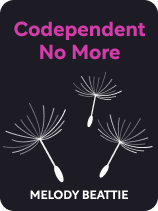

This article is an excerpt from the Shortform book guide to "Codependent No More" by Melody Beattie. Shortform has the world's best summaries and analyses of books you should be reading.
Like this article? Sign up for a free trial here .
What is codependent behavior? Why is it so difficult to properly define codependency?
The definition of codependency is constantly changing as the study of psychology evolves. Some doctors say that codependency is a situational response, while others go so far as to say it’s a disease.
Below, we will explore the history of codependency and its many definitions.
What Is Codependency?
Inthe book Codependent No More, Melody Beattie explores codependency and how it affects people. She draws on her own experience as a codependent, addict, and councilor to present a realistic yet compassionate image of codependents and their struggles. Furthermore, she shows how codependency can ruin lives just like addiction, and how, just like addiction, it can be overcome.
In Part 1, we’ll look at what codependency is and how it forms; we’ll discuss how to overcome it in Part 2. In this chapter, we’ll cover the definition of codependency, its characteristics, and its causes.
The Evolving Definition of Codependency
So, what is codependent behavior? According to Beattie, codependency is a stress-induced pattern of behavior that dictates how a person treats another and how she allows that other person to influence her. The codependent obsesses over the other person and seeks to control them.
Beattie cautions readers, though, that hers is not the definitive definition. Codependency occupies a nebulous place in the psychological field. Many definitions of codependency exist, all capturing an aspect of the condition. These definitions vary between doctors, clinics, and individuals. Some experts maintain that codependency is a disease, becoming worse over time, while others argue that codependent behavior is a normal response to an unhealthy situation.
Though many of these descriptions are outdated, they are useful for getting a better understanding of codependency. Let’s look at a few of the major definitions and discoveries that led to Beattie’s understanding of codependency.
| The Difficulty in Defining Codependency Defining codependency is a difficult task, even decades after Beattie’s work first brought widespread attention to the condition. Part of this difficulty is that codependency is not technically a mental illness according to the DSM-5, which provides information for diagnosing mental illnesses. There is no single, clear definition agreed upon by experts. The American Psychiatric Association denied codependency its own entry in the DSM-5 because it has too many overlapping symptoms with other diagnoses, such as dependent personality disorder (DPD) or borderline personality disorder (BPD). However, codependency has a few prominent traits that do not fit a DPD or BPD diagnosis: most notably the tendency to assume too much responsibility, as opposed to the shirking of responsibility defined in DPD and BPD. This points to codependency deserving its own diagnosis, and the issue is still debated among experts. Currently, codependency is generally defined as a dysfunctional relationship where Person A needs Person B, and Person B needs to be needed. Beattie’s definition remains one of the most comprehensive, as she addresses the cause of codependency as well as its symptoms. |
The History of Codependency
According to Beattie, codependency was initially defined as having unhealthy coping mechanisms for dealing with a loved one’s alcoholism. This definition remained until experts discovered that codependent people act like alcoholics, as if the codependents themselves have an addiction. The definition then focused more on the codependent’s loss of control in their life, rather than on the family member’s problems.
As experts conducted more research, they expanded the definition to include conditions other than alcoholism and refined it to describe the cause of the unhealthy coping mechanisms codependents displayed. At this point, codependents were known as people whose lives were out of control because of relationships with needy or dependent people.
Beattie asserts that the final major shift in defining codependency came with the realization that some families displayed codependent behavior without an external problem to cause it. This led to the discovery that family dynamics themselves can cause codependency. We’ll discuss this in more detail later in this chapter.
| When Codependency and Addiction Co-Present While Beattie argues that any prolonged stressful situation can cause codependency, and it may not be linked to addiction, the disorder is still closely linked to addiction because counselors discovered it at substance abuse clinics. Experts recognized patterns of behavior in the family members of the alcoholics they treated and, as the patterns became more obvious, changed their methods to support the families as well as the addicts. The connection between addiction and codependency goes both ways. While Beattie addresses the primary link (addiction causing codependency), the stress of being in a codependent relationship can drive people to substance abuse. Thus, treating codependency is vitally important. Some people believe that when addiction and codependency co-present, both disorders must be treated. Because each causes the other, only treating one won’t help. However, while most recommended treatments admit that the codependency needs to be treated, they maintain that treating the addiction is the main step to healing. |
Define Codependency for Yourself
While Beattie provides a definition of codependency, she maintains that having a single concrete definition is less important than being able to define codependency for yourself. Understanding your own codependency and how it affects you is the first step toward healing.
| The Dangers and Benefits of Self-Diagnosis Beattie maintains that self-diagnosing codependency is an important step toward healing. However, self-diagnosis is a controversial subject in psychiatry. Some doctors maintain that self-diagnosis is dangerous because it relies on personal research and inexpert opinions. People without psychological backgrounds can overlook important symptoms of mental illness. In addition, mistreating yourself based on an incorrect self-diagnosis can exacerbate your true condition. However, other doctors argue that self-diagnosis is actually a helpful tool: Doctors suffer from personal biases which affect how they diagnose patients. Self-diagnosis avoids these biases. Most poignantly for codependents, self-diagnosis changes how you view yourself and your condition. Once you have a name to put to your struggles, it is easier to accept that you need and deserve treatment: A codependent can go from thinking, “I’m a terrible person,” to, “I’m codependent and I can get better.” This shift in mindset is a powerful step toward healing. |

———End of Preview———
Like what you just read? Read the rest of the world's best book summary and analysis of Melody Beattie's "Codependent No More" at Shortform .
Here's what you'll find in our full Codependent No More summary :
- What inspired codependency 12 Step Programs around the country
- Explanations, advice, and compassion for people struggling with codependency
- How to practice detachment, self-care, and personal responsibility






